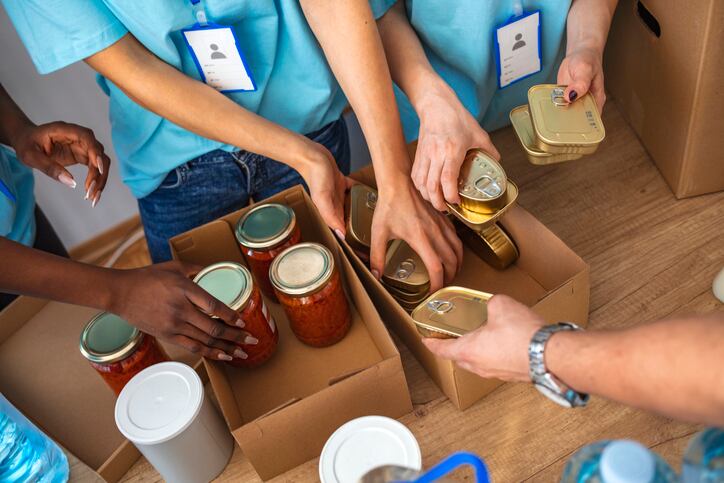At a House Agriculture Committee hearing March 11 looking at food insecurity in America, representatives from food banks, convenience stores, grocery retailers, the American Farm Bureau Federation and others proposed diverse solutions to feeding the rising number of Americans who don’t know when or from where their next meal will come.
Some of the proposed changes – such as expanding access to Supplemental Nutrition Assistance Program funds, commonly known as food stamps, or pandemic electronic benefit transfer (P-EBT) to help families cover the cost of meals children would have received for free or a reduced prices if school had been in session – could expand access to funds and sales at retailers, including grocery and convenience stores. Other proposals, such as redirecting funds from the Coronavirus Food Assistance Program (CFAP), commonly known as the Farmers to Families Food Box program, to large, established food banks, could more heavily concentrate aid among fewer players.
Despite these divergent views, all players agree that public-private partnerships are necessary to help rebuild the economy and ensure Americans do not go hungry.
The rising tide of hunger in America
Yesterday’s hearing was called by the House Agriculture Committee after the Congressional Budget Office predicted in February that negative effects of the pandemic will continue through most of 2022 with the number of Americans depending on SNAP benefits steadily rising before ebbing in 2023.
“Prior to the pandemic, in February of 2020, there were 36.8 million people on SNAP. By April of 2020, SNAP rolls were up to 40 million people and that increased to nearly 43 million people by September of last year,” House Agriculture Committee Chairman David Scott, said in comments prepared for the hearing.
He added that number could rise to 44 million by next year before it begins to decrease in 2023, according to the Congressional Budget Office’s Baseline Projects for the next 10 years for SNAP.
“So, even if this virus disappears, we are going to be living with its aftermath for some time. We need to be realistic about this and continue to work to shore up the people who are counting on us to help them through this crisis,” he told stakeholders gathered at the hearing.
Increase support, flexibility of SNAP other nutrition programs
One of the most effective ways to address food insecurity in America, at least temporarily, is to expand access to and benefits provided by SNAP, most of the witnesses gathered at the hearing agreed.
“Millions of Americans would not have the food they need to survive without the continued strong support of the federal nutrition programs. SNAP is the most important of these programs and stands as the nation’s first line of defense against hunger,” Kyle Waide, president and CEO of the Atlanta Community Food Bank, said in comments prepared for the hearing.
He noted that while Feeding America food banks, of which Atlanta Community Food Bank is one, will provide between six and seven billion meals this year, SNAP provides nine times that amount of food.
“Increasing, or decreasing SNAP benefits by 10% is equivalent to doubling or eliminating access to all of the food provided through our nation’s food banks,” he said. As such, he added, “My food bank strongly supports expanding access to SNAP” to improve the health and well-being of millions of families and alleviating pressure on food banks.
Increasing SNAP also would stimulate local economies, as the funds are spent – not saved – and usually go to area businesses.
For example, over the past year, the convenience store banner RacecTrac and its franchise-brand RaceWay saw SNAP transactions at its stores double, and saw a 65% increase in EBT dollars used at RaceTrac stores and a 102% increase at RaceWay stores, Max McBrayer, CEO of RaceTrac Petroleum, said in comments prepared for the hearing.
“Before COVID (2019 and early 2020), EBT accounted for around 0.7-1% of our total transactions; since March 2020 this has nearly doubled to 1.2%-1.6% of total transactions,” McBrayer said.
“It is clear to all of us at RaceTrac that in 2020 many of our guests have been struggling to make ends meet, and are experiencing food insecurity. Congress’ 15% increase of SNAP benefits has been critical to ensuring that our most economically vulnerable citizens have access to the food they need,” he said, urging the government to continue its heightened support of SNAP.
He also noted that P-EBT “has been important in ensuring that eligible school children are able to access food via temporary emergency EBT benefits while their schools are closed or operating with reduced hours.”
However, P-EBT is not perfect, noted Ron Edenfield, president of Wayfield Foods, Inc.
In comments prepared for the hearing, he praised the P-EBT program for being easily tailored to children in need while leveraging existing EBT rails, allowing families who already participate in SNAP to easily shop as they always have but with additional funds.
However, he said, access to P-EBT has been uneven during the current academic school year. He noted that while Georgia families received a one-time allotment of $256.50 in P-EBT benefits per child during the last school year, there have been no P-EBT benefits for this academic year.
“While the P-EBT program is not directly under the jurisdiction of this committee, I encourage this committee, in coordination with the House Education and Labor Committee to examine the program and why many states are facing so many challenges in being approved for the current school year,” he said.
He also encouraged them to expand the P-EBT model to cover the summer feeding program currently run by schools as it offers more flexibility around what food families can buy and when they access the food. For example, many low-income Americans work unconventional hours and may not be able to go to a school feeding site in the middle of the day to access a meal for their child – P-EBT offers another solution.
Tweaks to the Farmers to Family Food Box Program
Another critical but imperfect source of federal funds to feed Americans is the Coronavirus Food Assistance Program, commonly known as the Farmers to Families Food Box program, which was launched by USDA last April to leverage surplus food to support farmers and ranchers while also feeding families.
“CFAP food boxes have provided a critical source of food inventory for the Atlanta Community Food Bank and many food banks around the country,” but “food banks and communities have not had equitable access to CFAP product,” lamented Waide.
He explained that the food boxes have not been available in many parts of the country, which he attributes to the capacity and capabilities of the food service distributors awarded contracts and the nonprofits with which they work.
“We encourage USDA to rely more heavily on the well established distribution models and capabilities evidence in the TEFAP program, where food banks and other social service organizations have already developed the relationships and capacity to move large volumes of food safely and efficiently into the highest need areas of the country,” he said.
He added that with each round of contracts awarded through the CFAP model, “we are reinventing the supply chain for these products, a less efficient, equitable and sustainable operating model.”
As such, he asked legislators that if USDA renews the CFAP program it “examine whether more state and regional contracting with growers and producers would better support our agricultural community most impacted by the pandemic.”
Edenfield takes it one step farther, and adds that “existing food partnerships that distribute funds through an EBT card or through food banks are far more efficient and give parents the opportunity to shop at their convenience and to purchase the best foods for their children.”
For example, he noted the frustration some parents might feel if their box included peanut butter but their child has a peanut allergy.
Ultimately, most presenters agree that while the current systems are far from perfect they are desperately needed by the rising number of hungry Americans, which is why they called for all stakeholders to come together to improve access to food, nutrition education and create more jobs and economic growth as a long term solution.
‘Just the start’
Yesterday’s hearing “was just the start of the work the Agriculture Committee will do to address hunger and food insecurity in this country,” Scott said in a statement.
His added his top takeaways are that “SNAP works and we must do all we can to ensure that important program continues to provide assistance to those who need it,” and that legislators and stakeholders need to explore how grocers and convenience stores can help alleviate hunger – especially in rural communities.




